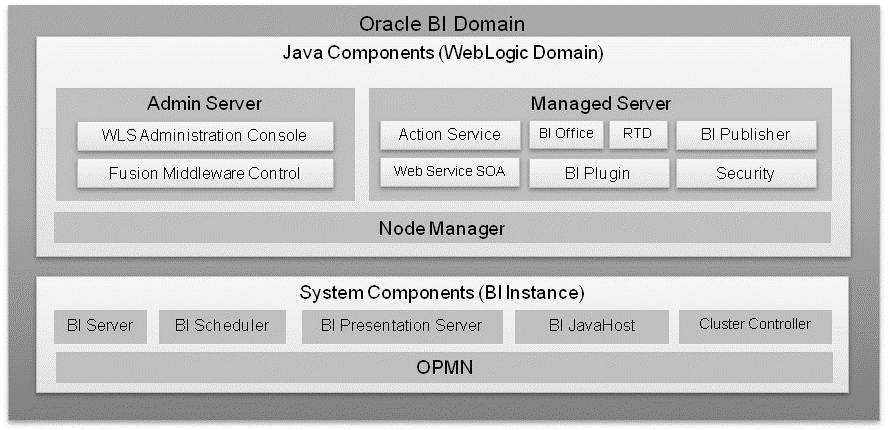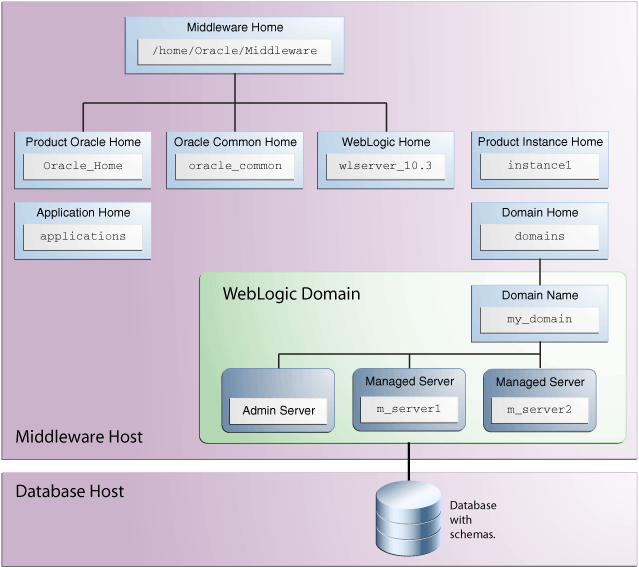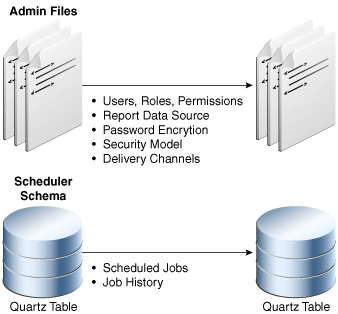| Oracle® Fusion Middleware Upgrade Guide for Oracle Business Intelligence 11g Release 1 (11.1.1) E16452-01 |
|
 Previous |
 Next |
| Oracle® Fusion Middleware Upgrade Guide for Oracle Business Intelligence 11g Release 1 (11.1.1) E16452-01 |
|
 Previous |
 Next |
The following sections introduce some key concepts of the Oracle Business Intelligence environment for 10g users.
Oracle Business Intelligence includes the following components:
Oracle Business Intelligence Enterprise Edition
Oracle Business Intelligence Publisher
Oracle Real-Time Decisions
You can install one, two, or all three of these products, using Oracle Business Intelligence Installer. Oracle Business Intelligence Installer creates all the runtime components and the infrastructure for the products you choose to install. After running Oracle Business Intelligence Installer, the installed products share the same Oracle Fusion Middleware infrastructure in a single WebLogic domain.
"Differences between Oracle Business Intelligence 10g and 11g Releases" in the Oracle Fusion Middleware Installation Guide for Oracle Business IntelligenceOracle Business Intelligence supports the following types of installation:
Simple Installation
Enterprise Installation
Software Only Installation
When installing Oracle BI for upgrade, select Enterprise Installation. The Enterprise Installation type enables you to install Oracle Business Intelligence components for a new 11g enterprise deployment to which you upgrade your 10g data.
What gets installed?
The Enterprise installation type does one of the following, depending on which option you choose during the installation:
New installation: Oracle Business Intelligence Installer installs the Oracle Business Intelligence components that you select.
Scale out an existing installation: Oracle Business Intelligence Installer installs all Oracle Business Intelligence components.
Select New installation to install a new Oracle BI 11g deployment for upgrade.
What gets configured?
For a New installation, Oracle Business Intelligence Installer configures the Oracle Business Intelligence components that you select and associates them with the Middleware, Oracle, and WebLogic Server homes that you specify.
Figure 3-1 provides the logical architecture for Oracle Business Intelligence after installation.
Figure 3-1 Oracle Business Intelligence Logical Architecture

The most significant difference between Oracle Business Intelligence 10g and 11g, is the deployment to Oracle WebLogic Server, and the integration of Oracle Business Intelligence with Oracle Fusion Middleware.
For more information about Oracle Fusion Middleware Components, see Chapter 1, "Introduction to Oracle Fusion Middleware" in the Oracle Fusion Middleware Administrator's Guide.
Oracle WebLogic Server Middleware Home
Oracle Business Intelligence requires a Middleware home with Oracle WebLogic Server on your system. If your system does not already have Oracle WebLogic Server, you can install it in a new Middleware Home directory.
A Middleware home is a container for the Oracle WebLogic Server home, and, optionally, one Oracle Common home and one or more Oracle homes, with a directory structure like this:
/middleware_home
wlserver_<version>
jdk_<verion>
oracle_common
BI_ORACLE_HOME
user_projects
The BI Oracle home contains the binary and library files necessary for Oracle BI. BI_ORACLE_HOME represents the BI Oracle home in path names.
The BI Oracle home can be associated with multiple Oracle WebLogic Server domains. The Oracle Common home contains the binary and library files required for Oracle Enterprise Manager 11g Fusion Middleware Control and Java Required Files (JRF).
A Middleware home can reside on a local file system or on a remote shared disk that is accessible through a network file system.
For more information about the structure and contents of a Middleware home, see "Understanding Oracle Fusion Middleware Concepts" in Oracle Fusion Middleware Administrator's Guide.
A typical Oracle Business Intelligence installation consists of a Fusion Middleware home and the following subdirectories:
wlserver_10.3: The WebLogic Server home, which contains Java components, one Administration Server, and one or more Managed Servers.
oracle_home: The Oracle Home contains binary and library files for Oracle BI.
oracle_common: The Oracle Common Home contains the binary and library files required for Fusion Middleware Control and Java Required Files (JRF). There can be only one Oracle Common home within each Middleware home.
Figure 3-2 shows the directory structure of a typical Oracle Fusion Middleware installation on a single host, using all of the default values.
Figure 3-2 Typical Oracle Business Intelligence Directory Structure

Table 3-1 describes the changes in directory structure from Oracle BI 10g to 11g.
Table 3-1 Oracle BI content changes
| Directory or Files | 10g Location | 11g Location |
|---|---|---|
|
AdminTool.sh equalizerpds.sh/equalizerpds.exe JobManager.sh MigrateEUL.sh NQClient.sh nqcmd.sh/nqcmd.exe |
BI_ORACLE_HOME/server/Bin |
BI_ORACLE_HOME/bifoundation/server/bin |
|
DBFeatures.INI NQSConfig.INI |
BI_ORACLE_HOME/server/Config |
ORACLE_INSTANCE/config/OracleBIServerComponent/coreapplication_obisn |
|
NQClusterConfig.INI |
BI_ORACLE_HOME/server/Config |
ORACLE_INSTANCE/config/OracleBIApplication/coreapplication |
|
NQQuery.log NQSAdminTool.log NQServer.log |
BI_ORACLE_HOME/server/Log |
ORACLE_INSTANCE/diagnostics/logs/OracleBIServerComponent/coreapplication_obis1 |
|
Oracle BI Server repository directory:
|
BI_ORACLE_HOME/server/Repository |
ORACLE_INSTANCE/bifoundation/OracleBIServerComponent/coreapplication_obisn/repository |
|
Samples:
|
BI_ORACLE_HOME/server/Sample/samplesales |
ORACLE_INSTANCE/bifoundation/OracleBIServerComponent/coreapplication_obisn/sample/SampleAppFiles |
|
Usage Tracking:
|
BI_ORACLE_HOME/server/Sample/usagetracking |
ORACLE_INSTANCE/bifoundation/OracleBIServerComponent/coreapplication_obisn/sample/usagetracking |
|
Other Schemas (for example):
Note: Use the Repository Creation Utility to install the Oracle BI Schema |
BI_ORACLE_HOME/server/Sample/Schema |
ORACLE_INSTANCE/bifoundation/OracleBIServerComponent/coreapplication_obisn/schema |
|
OracleBIData/web/config |
ORACLE_INSTANCE/config/OracleBIPresentationServicesComponent/coreapplication_obipsn |
|
OracleBIData/web/log |
ORACLE_INSTANCE/diagnostics/logs/OracleBIPresentationServicesComponent/coreapplication_obipsn |
|
catalogmanager.exe |
BI_ORACLE_HOME\web\catalogmanager |
ORACLE_INSTANCE\bifoundation\OracleBIPresentationServicesComponent\coreapplication_obipsn\catalogmanager\runcat.cmd |
|
instanceconfig.xml (for Oracle BI Scheduler) |
OracleBIData\web\config |
ORACLE_INSTANCE\config\OracleBISchedulerComponent\coreapplication_obischn |
|
BI_ORACLE_HOME/setup |
ORACLE_INSTANCE/bifoundation/OracleBIApplication/coreapplication/setup |
This section describes the components that are upgraded by Upgrade Assistant, as well as the security model upgrade path.
Figure 3-3 illustrates the Administration files and Scheduler schema components that are upgraded by Upgrade Assistant.
Figure 3-3 10g to 11g Report Catalog Upgrade Flow

Figure 3-4 illustrates the Report Catalog components upgraded by Upgrade Assistant.
The following table shows security model mapping for an Oracle BI Publisher upgrade.
Table 3-2 Oracle BI Publisher Security Model Flow
| 10g Security Model | 11g Security Model |
|---|---|
|
BI Publisher |
BI Publisher |
|
BI Server |
BI Server |
|
LDAP |
LDAP |
|
Database |
Database |
|
Siebel Security |
Siebel Security |
|
E-Business Suite Security |
E-Business Suite Security |
|
Shared Services Security |
Default (Oracle Fusion Middleware) |
The security policy for Oracle Business Intelligence 11g defines what individual users and users with certain application roles can access and do. In Oracle Business Intelligence 11g, the security policy definition is split across the following:
Presentation Catalog - this defines which catalog objects and Oracle BI Presentation Services functionality given users and application roles can access.
RPD - this defines which application roles and users have access to which items of metadata within the RPD. You define this security policy in the Administration Console.
Policy Store - this defines which Oracle Business Intelligence Server, Oracle Business Intelligence Publisher and Real Time Decisions functionality can be accessed by given users or users with given application roles. Use Oracle Enterprise Manager to configure the default Oracle Business Intelligence Policy Store.
Oracle Business Intelligence10g and 11g security models differ in the following areas:
Defining users and groups - in Oracle Business Intelligence 10g, it was possible to define users and groups within a repository file using the Oracle BI Administration tool. In Oracle Business Intelligence 11g, you can no longer define users and groups within a repository. The Oracle Business Intelligence Enterprise Edition Upgrade Assistant migrates users and groups from a 10g repository into the embedded LDAP server in an 11g installation.
Defining security policies - in Oracle Business Intelligence 10g, security policies in the Web catalog and repository can be defined to reference groups within a directory. In Oracle Business Intelligence 11g, security policies are defined in terms of application roles, which are in turn mapped to users and groups in a directory. This allows an Oracle Business Intelligence 11g system to be deployed without changes to the corporate directory and eases movement of artifacts between development, test and production environments.
Use of the Administrator user - in an Oracle Business Intelligence 10g installation, a special user named, Administrator has full administrative permissions and is also used to establish trust between processes within that installation. In Oracle Business Intelligence 11g there is no special significance to the name Administrator and there can be one or more users who are authorized to undertake different sets of administrative functions. In Oracle Business Intelligence 11g the identity used to establish trust between processes in an installation is configurable and independent.
Repository encryption - in Oracle Business Intelligence 10g, certain sensitive elements within a repository are encrypted. In Oracle Business Intelligence 11g, the entire repository is encrypted using a key derived from a user supplied password. An 11g repository can only be opened with the password, and there is no mechanism to recover a lost password.
The following aspects of the Oracle Business Intelligence 10g security model remain in 11g:
Oracle Business Intelligence Server Initialization Blocks - Oracle Business Intelligence Server 11g continues to support the use of initialization blocks for authentication and authorization. In 10g Oracle Business Intelligence Server falls back to use initialization blocks if a matching user cannot be found in the repository. In 11g Oracle Business Intelligence falls back to use initialization blocks if the user cannot be authenticated by the installation's configuration authentication provider.
Presentation Catalog Groups - Oracle Business Intelligence 11g continues to support the definition of catalog groups within the presentation catalog. These groups are only visible within Oracle Business Intelligence Presentation Services. Oracle recommends that presentation catalog groups be used for backward compatibility only and that application roles be used instead for new installations.
SA System Subject Area - Oracle Business Intelligence 11g supports the use of SA System Subject Area in combination with Oracle Business Intelligence Server initialization blocks to access user, group, and profile information stored in database tables.
For more information about Oracle Business Intelligence security, see the Oracle Fusion Middleware Security Guide for Oracle Business Intelligence Enterprise Edition.